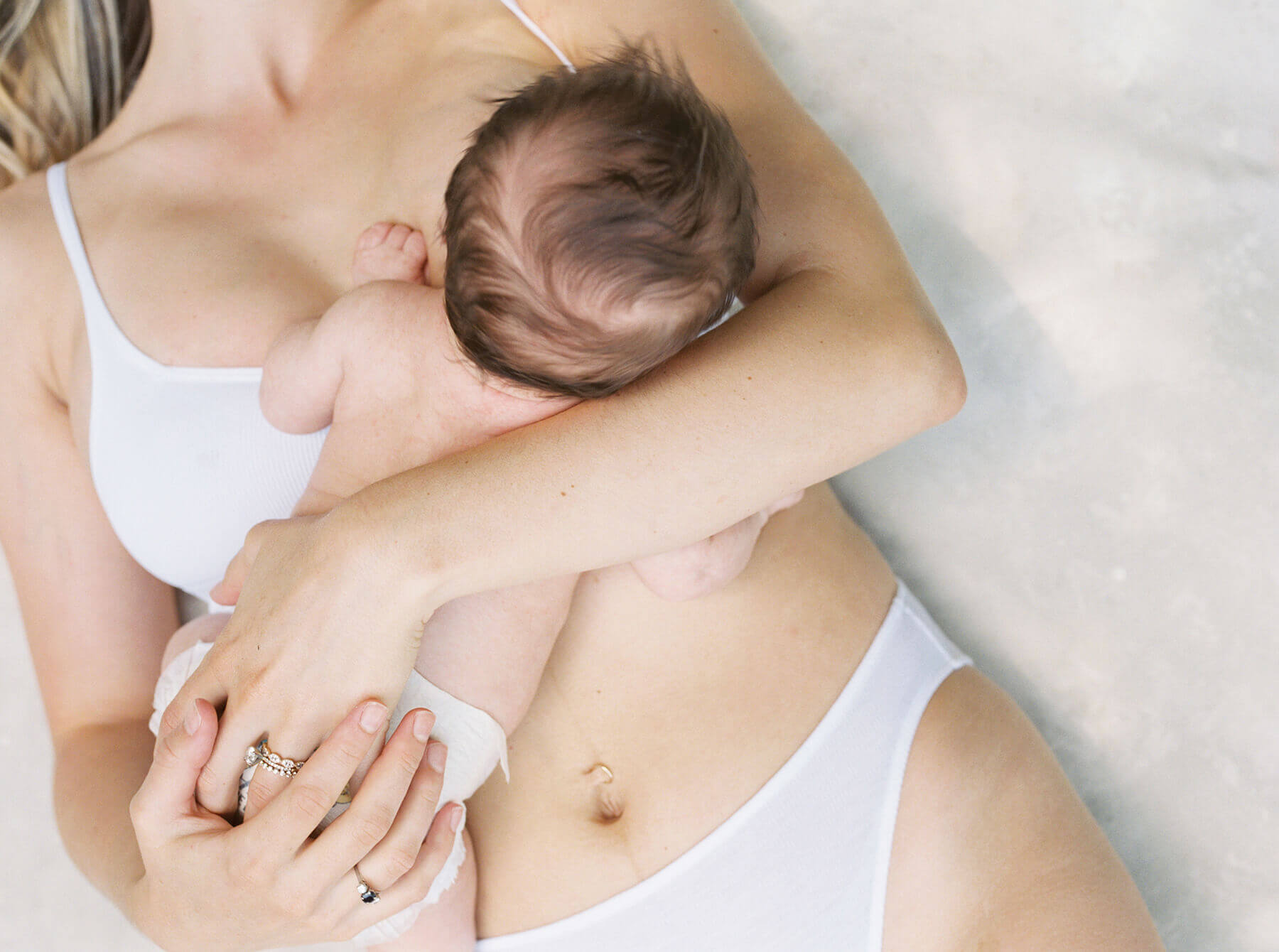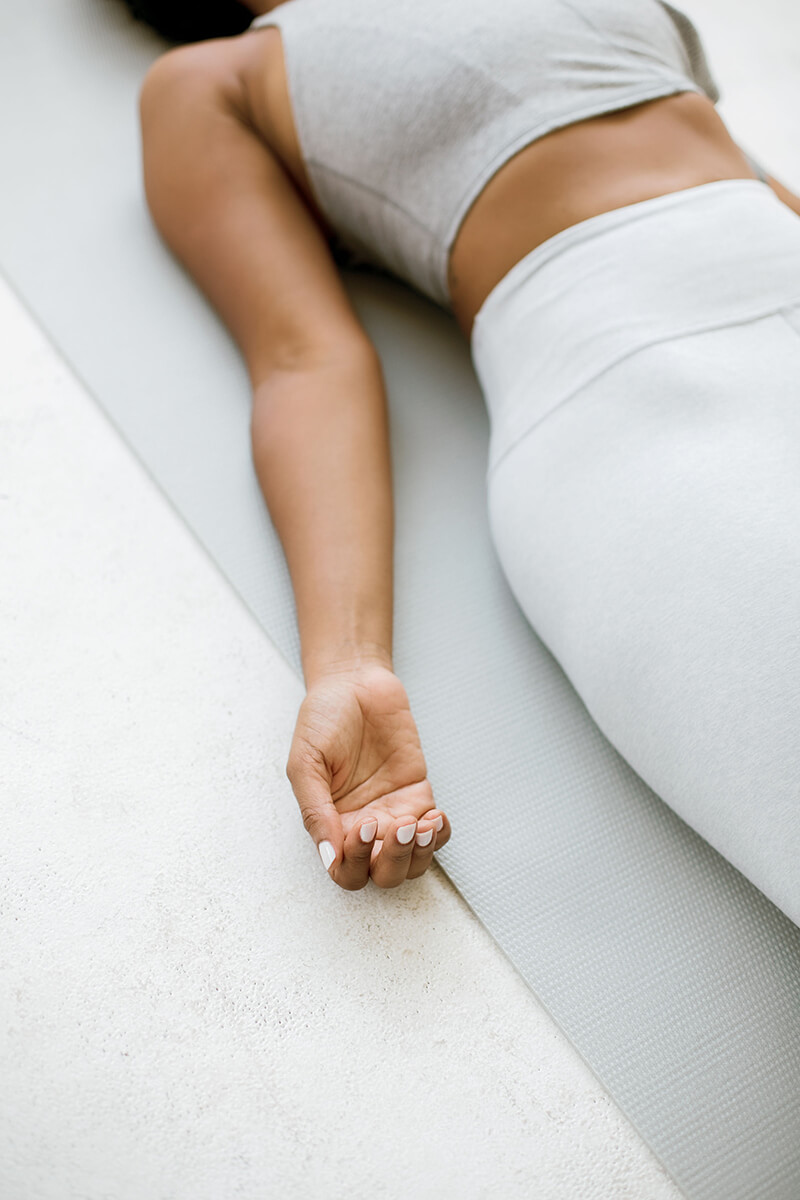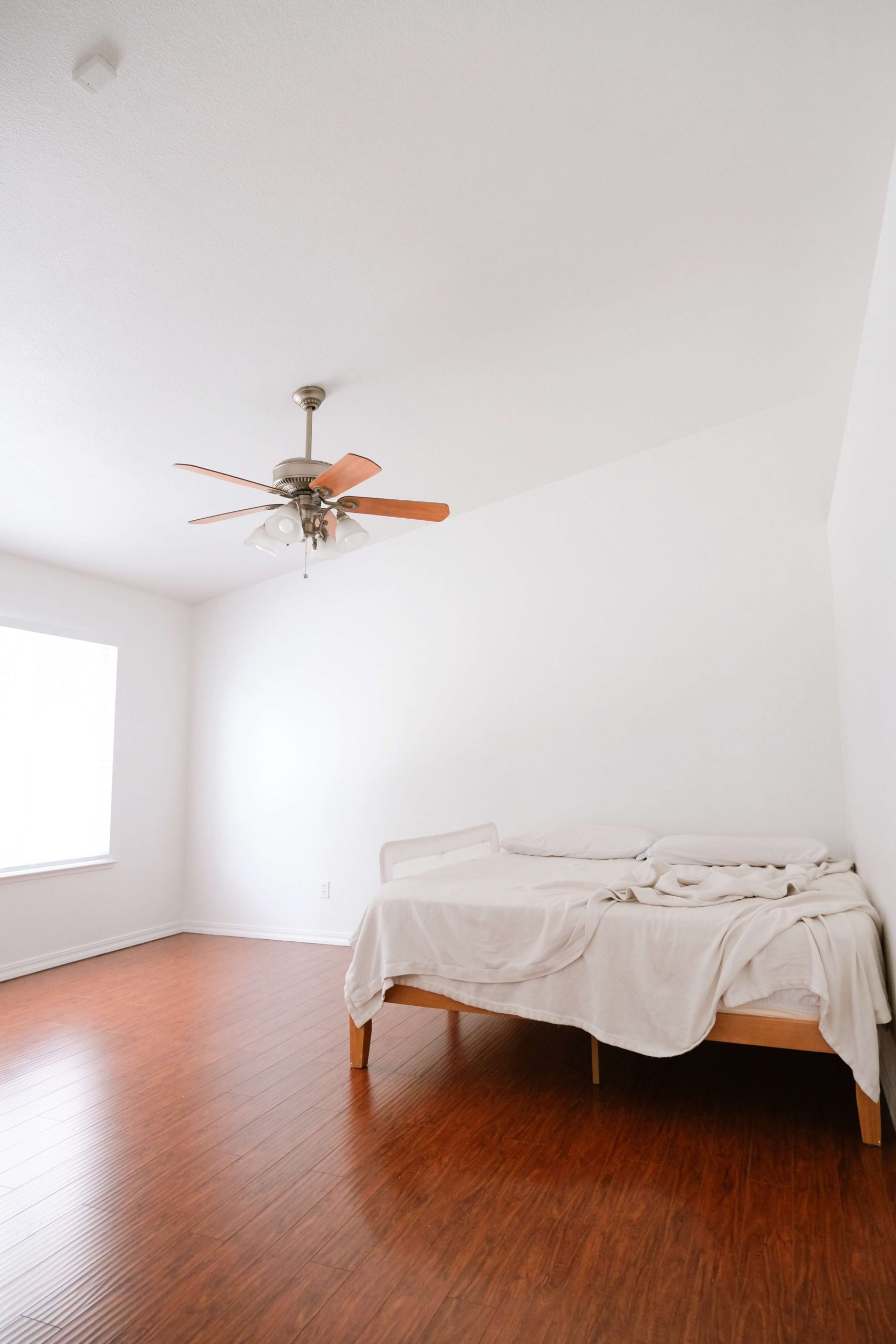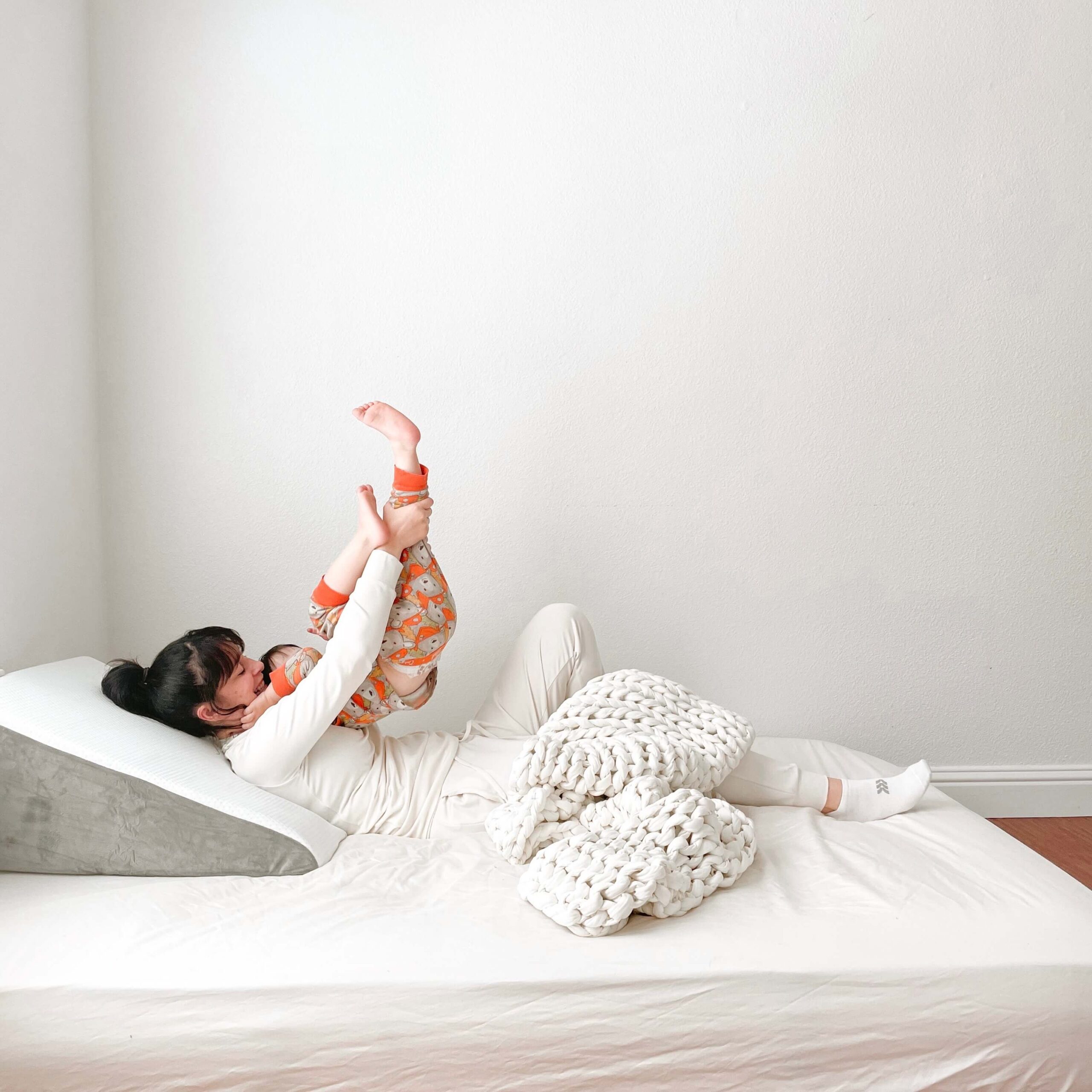Most new parents are shocked that their baby wants nothing to do with the shiny new bassinet. They haven’t done any research on how to bedshare. This sets them up for failure at 3 a.m. when they need to bring their baby into their bed, but don’t know how to do it safely.
The Two Ways to Bedshare With Your Baby:
- Chest Sleep with Your Baby on Your Mattress
- Cuddle Curl Your Baby on Your Mattress
Biological anthropologists have observed mothers all over the world bedsharing with their babies in two ways.
The first way is often called “chest sleeping,” and it consists of a parent sleeping chest-to-chest with their baby. The second is called “cuddle curling” and refers to a parent sleeping beside their baby.
Familiarize yourself with both techniques. Whether you plan on sleeping with your baby every night or it’s a one-time thing, it’s important to know how to do it safely.
Listen to this 10-minute episode on Apple Podcasts or Spotify.
1. Chest Sleep with Your Baby on Your Mattress
Something all new parents realize, and fast, is that a newborn is most comfortable on a warm chest.
Their happy place is right on top of their mother’s breasts – that warm, safe place where they can smell and reach her milk. Where they can feel her heart beating and drift in and out of sleep to her familiar voice.
For the majority of human history, this is precisely how our ancestors lived and slept.
How Did Babies Sleep Throughout Human History?
Human mothers and babies were rarely separated, and when they were, another female in the community would hold the baby. Centuries passed, and our species thrived by sticking together and nurturing the newcomers.
Modern life here in the West is wholly different, and most mothers have no choice but to raise their children without a community. Bassinets, bouncers, and swings are often necessary as a safe place to stow a baby when there’s not a support person around to take them into their arms.
What Are the Benefits of Bedsharing?
It’s important to note that while daily life has drastically changed for our species, our biology has not.
When mothers and babies cosleep today, their heart rates, brain waves, sleep states, oxygen levels, temperature, and breathing still influence one another.
That has not changed.
Cosleeping enables easy, on-demand nursing. This leads to a greater breastmilk supply, longer breastfeeding sessions and a longer breastfeeding period. Studies show that it increases baby’s safety, sleep duration for both mother and baby, and sensitivity to one another’s communication.
These documented benefits lead biological anthropologists to believe that mothers and babies are still intended to sleep together, even in our modern world.
Unfortunately their advice is at odds with the American Academy of Pediatrics, which recommends that parents share a bedroom with their baby – but not a bed.
But the AAP’s abstinence-only approach to bedsharing doesn’t work at 3 a.m. when a mother desperately pulls her baby into bed. It doesn’t serve parents, and worse, it puts their babies in danger.
Research shows that 70-80% of breastfed babies sleep with their mother some of the time in the early months (Ball, 2022). So all new moms should receive information on safe bedsharing, just in case.
Can I Bedshare With My Baby?
Let’s start with you and your baby. If you are a non-smoker and sober, and your newborn arrived healthy, at full term, you two have been given the green light.
And now, let’s take a look at where you’ll bedshare.
Is your mattress firm? A firm sleep surface is a crucial component to safe bedsharing, so you may need to invest in a new one.
Tap here to download a mattress firmness test you can do at home right now, to ensure that your mattress is firm enough for safe bedsharing.
If you find that you do need to purchase a new mattress, here are the three most important factors you’ll want to look for.
How to Bedshare With Baby on Your Chest:
- Dress your baby and yourself lightly, as they’ll be absorbing some of your body heat. You don’t want them to overheat.
- Prop yourself up with pillows in the center of your firm mattress. Make sure the pillows are behind your body, so they won’t pose a suffocation risk for your baby.
- Place baby’s face on your chest, near your heart. As they lie on your, their body should be parallel with yours.
- Hold onto their bottom or lower back as you sleep, to ensure they don’t slip off.
Sweet Sleep recommends waiting until you feel a “friction fit,” so you’ll know your baby won’t slide off.
You can layer thin, breathable blankets over your legs if needed. You’ll want to keep the area around your body clear of anything soft or fluffy, in case your baby slips down while you’re sleeping.
Why Do I Have to Recline at an Angle?
It’s important to prop yourself up so your baby won’t be lying prone, or flat on their tummy. When they’re lying on you at an upward angle, their body weight will fall on their bottom and legs, not on their chest. Their lungs will be free to open to capacity.
Your baby will find a perfect, snug position on you, and slipping off is rare. But if you’ve created a safe bedsharing surface for your baby, they will likely be okay if it does happen.
These are the four components to a safe bedsharing surface:
- Firm
- Flat
- Level
- Clear
For this reason, you should never fall asleep with your baby while you’re on a couch or chair. Most of the statistics about “cosleeping” fatalities involve a couch – not a bed.
As long as you follow these safety guidelines from the experts in the field, you can confidently fall asleep as your baby safely sleeps on your chest.
Dive deeper into the safety, comfort, and logistics of sleeping chest-to-chest with your baby in the Chest Sleeping FAQ guide.
2. Cuddle Curl Your Baby on Your Mattress
Some moms and babies prefer to sleep side by side, instead.
You’ll need a firm mattress that doesn’t sag or dip too deep underneath your body. Your baby will fall asleep on their side, as they’re nursing, so you’ll need to make sure their head isn’t in a pocket of air.
Most babies will unlatch from your breast in their sleep and roll backwards on their own. If not, Safe Infant Sleep advises you to roll them backwards, onto their back, any time you notice it.
Does My Baby Need to Bedshare on Their Back?
As they get stronger and you feel more comfortable with it, you can let them sleep on their side. They’ll likely be thrilled, as they can park right in front of your breasts and nurse on demand.
The major safety rule to pay attention here is that a baby younger than 12 months should never sleep on their tummy on your mattress. While it’s safe for a baby to sleep on their tummy in a crib, once they learn how to roll both ways, this does not apply to bedsharing on an adult mattress.
Remember that the firmest adult mattress is still softer than a crib mattress.
The great news is that it’s a lot easier to keep a wiggle worm on their back if you’re sleeping in the cuddle curl position.
How to Bedshare Beside Your Baby on Your Mattress:
- Position yourself in the center of the mattress, on your side.
- Bend your knees in front of you, so that they’ll prevent you from accidentally rolling forward in your sleep.
- Nurse your baby in the side-lying position. Once they’re asleep, they’ll sleep on their back (or on their side, if they’re older) right there in front of you. Mere inches away.
Your body’s “C” position will help contain them, so they won’t be able to roll away from you and get into trouble while you sleep.
It also facilitates easy breastfeeding throughout the night. All your baby will have to do is simply turn their head and latch.
Ready to nurse from the other side? Carefully crawl over your baby to the other side of the mattress. Or you can gently roll your baby over your body, so that they’re on the other side of the mattress.
You two will figure out a rhythm that works well for you. You won’t just learn how to bedshare safely, but you’ll figure out how to do it comfortably, too.
Dive deeper into the safety, comfort, and logistics of cuddle curling around your baby in the Cuddle Curl FAQ guide.
It’s Never Too Late to Teach Yourself How to Bedshare
I know from experience that it can feel overwhelming and scary to bring your baby into your bed. It makes sense! “Independent sleep” is pushed on us from every direction. But if there’s a small voice inside that’s telling you that cosleeping is right for your family, listen.
It’s okay that, at first, you didn’t know how to bedshare. No one told you.
Trust your instincts. Stay diligent with these safety guidelines. And let go. Enjoy this precious, limited time you have to sleep cuddled up with your baby.






Hi there.
I was wondering if you have a pillow recommendations for chest sleeping? Any pillows that are comfortable & raise the mother’s body at an angle.
Thank you! 😊
Yes! And I should link them in this post, shouldn’t I?! I’m so glad you asked. 🙂
So here is the best high-quality, long-lasting pillow I’ve found that will last years (choose the 10″ one).
And here is a list of more affordable options, but they won’t last as long.